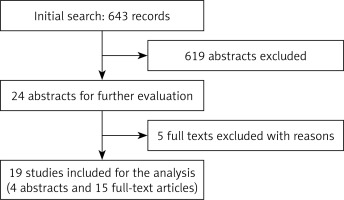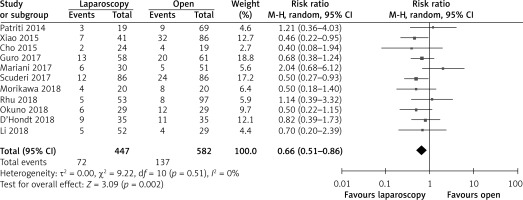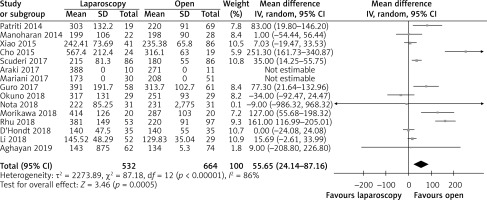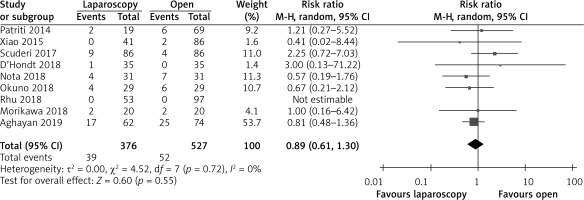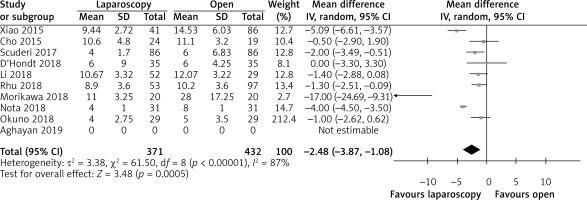Introduction
Laparoscopy has become the gold standard in many surgical interventions. Its advantages over an open approach are undisputable regarding postoperative pain, recovery time, and length of stay. Moreover, many authors underline that this approach is not inferior considering oncological outcomes [1–3].
However, liver surgery is considered a complex procedure with many technical difficulties. A significant number of procedures are performed on cirrhotic livers with portal hypertension, making the surgery even more demanding [4]. The cirrhotic liver has limited abilities for regeneration, which forces surgeons to limit the extent of resected tissue to preserve liver function [5].
Despite the technical requirements, the laparoscopic approach proved to be a feasible method even for complex liver resections, surpassing an open approach in terms of reduced overall morbidity [6]. As an example, laparoscopic left sectionectomy has become a routine method; however, it is recommended only for experienced surgeons [7]. Nonetheless, little is known about the most difficult procedures, such as surgical removal of lesions localised in segments 4A, 6, 7, and 8 (according to Couinaud classification), also known as posterolateral.
Aim
The aim of our study was to evaluate different aspects of laparoscopic liver resections of the posterolateral segments with regard to the safety (morbidity) and difficulty (operative time, blood loss).
Material and methods
Search strategy
In September 2019 a search of the Medline, Embase, and Scopus databases was conducted for publications on posterolateral resections of the liver. In an effort to be more comprehensive, we did not introduce any language restrictions to the search. Supplementary file 1 includes the full search strategy for the OVID platform. Also, we manually looked for other relevant publications in the referred studies.
Inclusion criteria for further analysis were: (1) studies comparing open and laparoscopic resections of the lesions located in posterolateral (4A, 6, 7, 8) segments of the liver, and (2) reporting overall morbidity, operative time, and major complications.
Two independent teams performed abstract and full-text screening of the articles. Where inclusion of the study was debatable, the teams attempted to reach a consensus. In cases of doubt, the decision was made by a third, independent reviewer. The extraction of data was performed independently by both teams. In our study, we did not intend to retrieve additional data that was not included in the manuscript directly from the authors. The study quality was assessed using the Newcastle-Ottawa scale [8].
Outcome measures
The outcome measures of this systematic review were: overall morbidity, major complications, operative time, intraoperative blood loss, resection margin, non-R0 resection rate, and length of hospital stay.
Statistical analysis
For analytic purposes, we used RevMan 5.3 (freeware from the Cochrane Collaboration). Statistical heterogeneity and inconsistency were measured using Cochran’s Q tests and I2, respectively. Qualitative outcomes from individual studies were analysed to assess individual and pooled risk ratios (RR) with pertinent 95% confidence intervals (CI), favouring laparoscopic over the open approach, and by means of the Mantel-Haenszel random-effects method. In cases when data were presented by medians and interquartile ranges, we calculated the mean ± SD using a method proposed by Hozo et al. [9]. Weighted mean differences (WMD) with 95% CI are presented for quantitative variables using the inverse variance random-effects method. Statistical significance was observed at a two-tailed 0.05 level for the hypothesis and 0.10 for heterogeneity testing, while unadjusted p-values were reported accordingly. This study was performed according to the Preferred Reporting Items for Systematic Reviews and Meta-Analyses (PRISMA) guidelines and Meta-Analysis of Observational Studies in Epidemiology (MOOSE) consensus statement [10, 11].
Results
The initial search yielded 643 records after removal of the duplicates. After abstract screening we selected 19 studies, with 15 full texts available, covering 532 patients in the laparoscopic group and 664 patients in the open (1196 patients in total). The PRISMA flowchart presented in Figure 1 summarises the screening process. Baseline information on included studies is presented in Table I [12–26]. All studies eligible for evaluation with the Newcastle-Ottawa scale were ranked as high quality.
Table I
Details of included studies ordered by year ascending
| Study | Year | Design | N Lap./Open | % male Lap./Open | Age Lap./Open | Lesion type | Full-text | NOS |
|---|---|---|---|---|---|---|---|---|
| Patriti [12] | 2014 | C | 19/63 | 63.2/60.9 | 62.6/63.2 | Metastasis, HCC, Other | Yes | 7 |
| Manoharan [13] | 2014 | C | 22/28 | N/A | N/A | N/A | No | N/A |
| Cho [14] | 2015 | C | 24/19 | 70.83/84.21 | 53.9/60.0 | HCC | Yes | 8 |
| Xiao [15] | 2015 | C | 41/86 | 82.93/89.53 | 52.1/50.3 | HCC | Yes | 8 |
| Guro [16] | 2017 | C | 58/61 | N/A | N/A | HCC | No | N/A |
| Scuderi [17] | 2017 | CM | 86/86 | 62.8/58.1 | 64.0/63.9 (median) | Metastasis, HCC | Yes | 7 |
| Mariani [18] | 2017 | C | 30/51 | N/A | N/A | HCC | No | N/A |
| Araki [19] | 2017 | C | 10/11 | N/A | N/A | No | N/A | |
| Li [20] | 2018 | C | 52/29 | 32.7/31.0 | 48.96 | HCC, Hemangioma, Metastasis | Yes | 8 |
| Rhu [21] | 2018 | C | 53/97 | 81.1/83.5 | 58.0/58.2 | HCC | Yes | 7 |
| D’Hondt [22] | 2018 | CM | 35/35 | 51.4/65.7 | 64.0/64.0 (median) | Metastasis, HCC, Others | Yes | 7 |
| Morikawa [23] | 2014 | CM | 20/20 | 70/70 | 64/65.5 (median) | Metastasis, HCC, Others | Yes | 9 |
| Okuno [24] | 2018 | CM | 29/29 | 48,3/51,7 | 54/54 (median) | Metastasis | Yes | 9 |
| Nota [25] | 2018 | CM | 31/31 | 65/55 | 59/57 (median) | Metastasis, HCC, Others | Yes | 8 |
| Aghayan [26] | 2019 | C | 62/74 | 50/65 | 66/67 | Metastasis, HCC, Others | Yes | 7 |
Overall morbidity was reported by 11 authors (N = 1029 patients). There was a significant difference in favour of the laparoscopic approach: MD = 0.66; 95% CI: 0.51–0.86; p = 0.002 (Figure 2). The heterogeneity between studies was low; I2 = 0.02%.
Major complications were reported in 10 studies (N = 900 patients). There were no significant differences between the groups: MD = 0.60; 95% CI: 0.35–1.00; p = 0.05 (Figure 3), and the heterogeneity between studies was low; I2 = 0%.
Figure 3
Major complications
CI – confidence interval, df – degrees of freedom, M-H – Mantel-Haenszel.
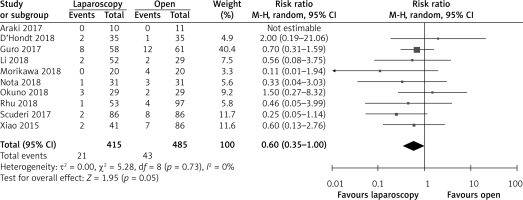
Operative time was reported by 15 authors (N = 1196 patients). There were significant differences in favour of the open approach: MD = 55.65; 95% CI: 24.14–87.16; p < 0.001 (Figure 4), although the heterogeneity between studies was significant; I2 = 86%.
Blood loss was reported by 12 authors (N = 862 patients); however, two of them did not include all required data for further estimation (SD, IQR, or range). There were no significant differences between the groups: MD = –41.46; 95% CI: –220.02, 260.00; p = 0.65 (Figure 5). Heterogeneity analysis reported a substantial measure of I2 = 96%.
Figure 5
Intraoperative blood loss
CI – confidence interval, df – degrees of freedom, IV – inverse variance.
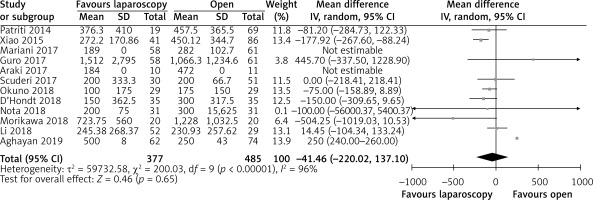
Resection margin was reported by five authors (N = 554 patients). There were no significant differences between the groups: MD = –0.23; 95% CI: –0.76, 0.31; p = 0.41 (Figure 6). Heterogeneity between studies was again significant, with I2 = 72%.
Non-R0 resection was reported by nine authors (N = 903 patients), although the study by Rhu et al. did not have cases of non-R0 resection in their material. There were no significant differences between the groups: MD = –0.89; 95% CI: 0.61–1.30; p = 0.55 (Figure 7). The heterogeneity between studies was low; I2 = 0%.
Length of stay was reported by nine authors, including N = 803 patients. There was a significant difference in favour of the laparoscopic approach: MD = –2.48; 95% CI: –3.87, –1.08; p < 0.001 (Figure 8). However, heterogeneity between studies was significant, I2 = 87%.
Discussion
In our meta-analysis we revealed that posterolateral liver resection is both a feasible and safe method in the treatment of lesions localised in segments 4A, 6, 7, and 8. We showed that the laparoscopic approach is superior in terms of overall morbidity and length of hospital stay. An open approach had a shorter mean operative time. Due to the small number of studies comparing open and laparoscopic techniques in posterolateral resections, we decided to also include conference abstracts in order to obtain as much data as possible. It enabled us to analyse a group of 1196 patients.
For the patients, one of the most important things during treatment is the safety of the procedure. In our study, we showed a number of benefits of laparoscopic technique in comparison to the open approach. At first, overall morbidity was lower in the laparoscopic group, and only three of the included studies reported lower morbidity in the open group [12, 16, 18]. Regarding major complications, the results were not statistically significant, although only D’Hondt et al. and Okuno et al. reported a higher rate in the laparoscopic group [22]. Nonetheless, meta-analyses considering all kinds of liver resections proved the laparoscopic approach to be both safe and efficient. Witowski et al. included 43 studies with 5100 patients treated for hepatocellular carcinoma [6]. In their study, not only morbidity was reduced in the laparoscopic group, but the perioperative mortality was also comparable.
Our analysis showed operative time to be shorter in the open approach. In general, major procedures with laparoscopic approach take longer than open surgery. However, in this specific case the learning curve might have affected the results. Longer surgery duration was found to be related to early phases of introduction of the laparoscopic approach [27]. It is very rarely reported whether surgeons have already reached the proficiency, which limits the possibility to interpret the results. Additionally, heterogeneity between the studies was high, making it difficult to generalise the clinical value. Moreover, longer surgery duration may have little impact clinical outcomes.
There is no consensus as to whether the laparoscopic technique decreases blood loss or not. Complex laparoscopic procedures have a steep learning curve, causing worse short-term outcomes at the beginning [28, 29]. In our study, there were no differences between the groups. The only included research reporting higher blood loss was a study by Guro et al., although the results are not significant. We also did not analyse the rate of Pringle manoeuvres performed during the surgery, which diminishes blood loss in complex liver resections.
Length of stay was shorter in the laparoscopic group. It has previously been proven that the laparoscopic approach is beneficial for patients in terms of less postoperative pain and faster recovery and lower morbidity, which also leads to a faster discharge from the hospital [30]. Nonetheless, the heterogeneity between the studies was high, thus the results should be carefully interpreted.
Our study has some limitations. First, the procedures had been performed in high-volume centres, which limits the introduction of our conclusions to clinical practice in smaller hospitals. Second, there is no technical standardisation of the minimally invasive approach, which comprises different methods of dissection and trocar placement. Moreover, pooled analyses revealed significant heterogeneity in a number of evaluated outcomes. To minimise the negative impact of heterogeneity we used a random-effects model instead of a fixed one. We also performed sensitivity analyses without outlying studies. Furthermore, minimally invasive liver resections are complex and demanding procedures, requiring a suitable learning curve to gain proficiency. Most of the included studies commented on mid-sized groups of patients, which could diminish the positive effect of laparoscopic surgery. Finally, all analysed studies were non-randomised, which creates further bias and limits interpretability of the results.










